CSAPPLab1-DataLab

1、bitXor
异或:不是同时为0和不是同时为1的情况进行按位与
/ bitXor - x^y using only ~ and &* Example: bitXor(4, 5) = 1* Legal ops: ~ &* Max ops: 14* Rating: 1*/int bitXor(int x, int y)
{return ~(~x & ~y) & ~(x & y);
}2、tmin
int最小值就是符号位为1,其他为0
/ tmin - return minimum two's complement integer* Legal ops: ! ~ & ^ | + << >>* Max ops: 4* Rating: 1*/int tmin(void)
{return 0x01 << 31;
}3、isTmax
我们考虑四位的最大值x=0111 然后x+1之后就会变成1000,我们对1000取非0111就会重新变回x值,已知自己与自己异或会得到0,也就是说我们可以用异或来判断等于!((~(x+1)^x)) 是否为1即可判断是否为最大值。这里有一个例外就是x=-1,由于-1=1111 他利用上面的式子判断也符合,故要特判-1,利用!!(x+1) 这个操作-1和最大值并不相同
/ isTmax - returns 1 if x is the maximum, two's complement number,* and 0 otherwise* Legal ops: ! ~ & ^ | +* Max ops: 10* Rating: 1*/int isTmax(int x)
{return !(~(x + 1) ^ x) & !!(x + 1);
}4、allOddBits
A=1010, A是一个典型的奇数位都是1的数(起始位为第0位),那只要一个四位的二进制数X & A = A就说明这个二进制符合条件,即只要判断x & 0xAAAAAAAA == 0xAAAAAAAA 就可以了。
由于不能直接定义0xAAAAAAAA ,我们需要一些位运算的小技巧
/ allOddBits - return 1 if all odd-numbered bits in word set to 1* where bits are numbered from 0 (least significant) to 31 (most significant)* Examples allOddBits(0xFFFFFFFD) = 0, allOddBits(0xAAAAAAAA) = 1* Legal ops: ! ~ & ^ | + << >>* Max ops: 12* Rating: 2*/int allOddBits(int x)
{int mask = 0xAA; // 0xAAmask = (mask << 8) + mask; // 0xAAAAmask = (mask << 16) + mask; // 0xAAAAAAAAreturn !((x & mask) ^ mask);
}5、negate
A + ~A = -1 和 A + (-A) =0 利用这两个式子我们可以得到 (-A) = ~A + 1
int值机器数为补码,补码取负为: 所有位取反然后加1即可
/ negate - return -x* Example: negate(1) = -1.* Legal ops: ! ~ & ^ | + << >>* Max ops: 5* Rating: 2*/int negate(int x)
{return ~x + 1;
}6、isAsciiDigit
我们可以看到“十”位必须是3, 并且只需要“个”位小于A即可,这里的小于运算 ,用了 a < b = a + (-b) < 0的性质,x & 0xF保存了x的后四位, 加上(-A)是否为负数来判断后四位的范围,判断负数是与0x1 << 31进行按位与运算,如果结果最高位为1则为负数
/ isAsciiDigit - return 1 if 0x30 <= x <= 0x39 (ASCII codes for characters '0' to '9')* Example: isAsciiDigit(0x35) = 1.* isAsciiDigit(0x3a) = 0.* isAsciiDigit(0x05) = 0.* Legal ops: ! ~ & ^ | + << >>* Max ops: 15* Rating: 3*/int isAsciiDigit(int x)
{int ah = !(x >> 4 ^ 0x3);int al = x & 0xF;int minus_a = ~0xA + 1;int flag = 0x1 << 31;return ah & !!((al + minus_a) & flag);
}7、conditional
当x非0, 则!x为0, !!x为1, 令x = !!x,则此时~x+1为全1
若x为0, 则!!x为0, ~x+1还是为0
/ conditional - same as x ? y : z* Example: conditional(2,4,5) = 4* Legal ops: ! ~ & ^ | + << >>* Max ops: 16* Rating: 3*/
// x > 0 return y else return zint conditional(int x, int y, int z)
{x = !!(x);x = ~x + 1;return (x & y) | ((~x) & z);
}8、isLessOrEqual
注意:直接用x-y可能会爆int故不能通过这样简单的判断, 故进行分类讨论
- case 1代表x < 0, y > 0,
- case 2代表x > 0, y < 0。
- 在x y同号时(同大于0或同小于0时),我们可以放心的进行x-y操作,这样确保不会因为溢出而导致结果的符号错误,因此这两种情况可以合并为一种情况, 即case 3。
显然case 1是符合条件的,case 2不符合条件但它却是统一讨论情况3的障碍,所以最终在返回条件中一定要有!case 2来将情况2排除掉,再与两种同号条件相与。
/ isLessOrEqual - if x <= y then return 1, else return 0* Example: isLessOrEqual(4,5) = 1.* Legal ops: ! ~ & ^ | + << >>* Max ops: 24* Rating: 3*/
// 若x<=y则返回1, 否则返回0int isLessOrEqual(int x, int y)
{int sign_x = (x >> 31) & 0x1;int sign_y = (y >> 31) & 0x1;// case 1: x为-,y为+int case_1 = sign_x & (!sign_y);// case 2: x为+,y为-int case_2 = (!sign_x) & sign_y;// case 3: x与y同号int minus_y = (~y) + 1; // -yint sum = x + minus_y; // x + (-y) = x - y// 判断sum是否 <= 0// 判断 = 0,若sum == 0, eq一定为1int eq = !sum;// 判断 < 0,若sum < 0,less一定为1int less = (sum >> 31) & 0x1;return case_1 | (!case_2 & (eq | less));
}9、logicalNeg
非零数x,-x | x一定可以保证符号位为1。而对于0,这样的结论是不成立的,这就找到了能够完全区分0值和非0值的一个清晰的边界。
/ logicalNeg - implement the ! operator, using all of* the legal operators except !* Examples: logicalNeg(3) = 0, logicalNeg(0) = 1* Legal ops: ~ & ^ | + << >>* Max ops: 12* Rating: 4*/int logicalNeg(int x)
{int res = ((x | (~x + 1)) >> 31); // //除了0以外,其他的数都可以让res取到全1return res + 1; // res=0xffffffff, 因为int右移符号扩展 x|(~x+1)在x非0情况下必定是负数
}10、howManyBits
为了便于处理,将负数转换成对应的反码,再求解最高位1所在的位置
正数的话直接求解最高位1所在的位置即可。最终结果为,最高位1所在的位置 + 1(符号位),比如,0111 -> 3 + 1(符号位)
注:这里最高位所在的位置表示该位置是第几位(从1开始计算), 第一位、第二位、......
求解最高位1所在位置使用二分法:
如果x的高16位不为0,将x右移16位,然后用b16记录一下最高位1后面至少有16个数,
x右移16位之后,再接着二分,右移8位,
如果x的高8位不为0,将x右移8位,然后用b8记录一下最高位1后面至少有8个数
以此类推,最后将最高位1后面的数(包括自己)都加起来,即b16 + b8 + b4 + b2 + b1 + b0,再加一个符号位,即为最终答案b16 + b8 + b4 + b2 + b1 + b0 + 1
/* howManyBits - return the minimum number of bits required to represent x in* two's complement* Examples: howManyBits(12) = 5* howManyBits(298) = 10* howManyBits(-5) = 4* howManyBits(0) = 1* howManyBits(-1) = 1* howManyBits(0x80000000) = 32* Legal ops: ! ~ & ^ | + << >>* Max ops: 90* Rating: 4*/int howManyBits(int x)
{int b16, b8, b4, b2, b1, b0;int sign = x >> 31;x = (sign & ~x) | (~sign & x);b16 = !!(x >> 16) << 4; // 10000, 16x = x >> b16;b8 = !!(x >> 8) << 3; // 1000, 8x = x >> b8;b4 = !!(x >> 4) << 2; // 100, 4x = x >> b4;b2 = !!(x >> 2) << 1; // 10, 2x = x >> b2;b1 = !!(x >> 1); // 1, 1x = x >> b1;b0 = x;return b16 + b8 + b4 + b2 + b1 + b0 + 1;
}浮点数部分最重要的是理解下面这张图(太重要了!!!,不然根本没思路解题)
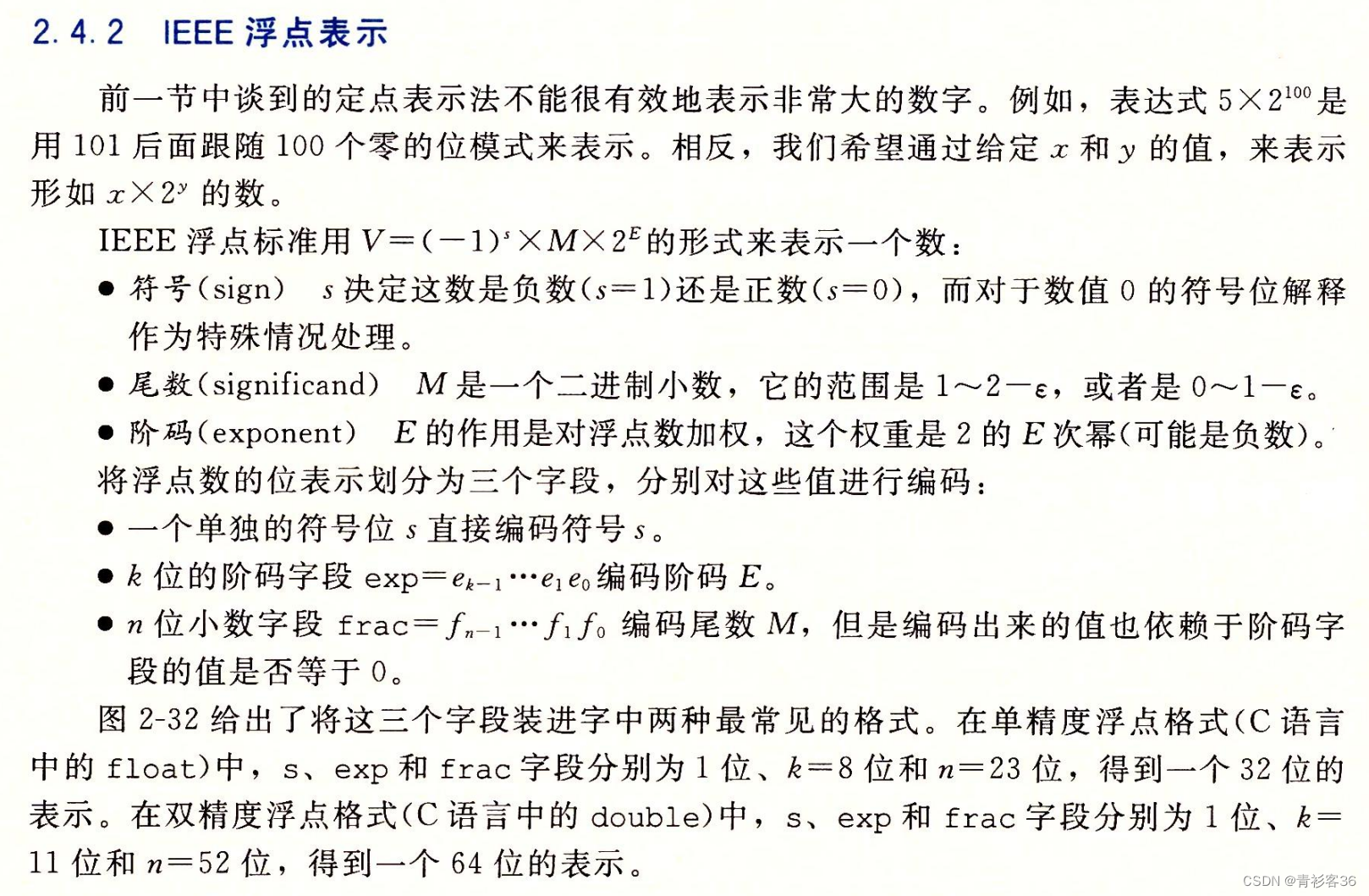
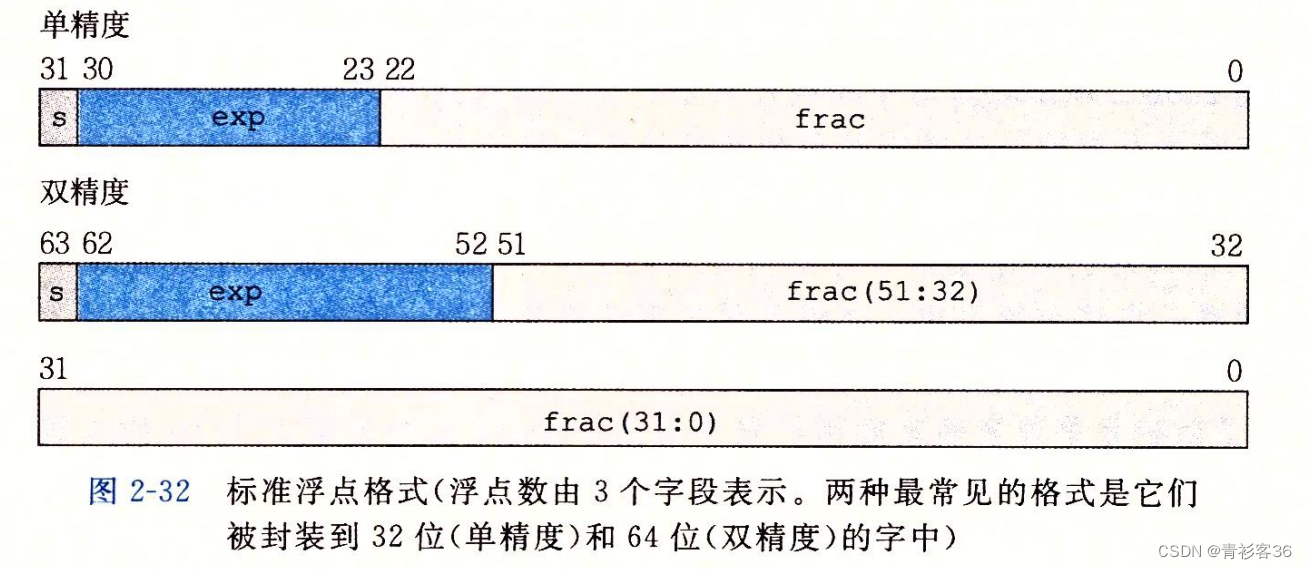
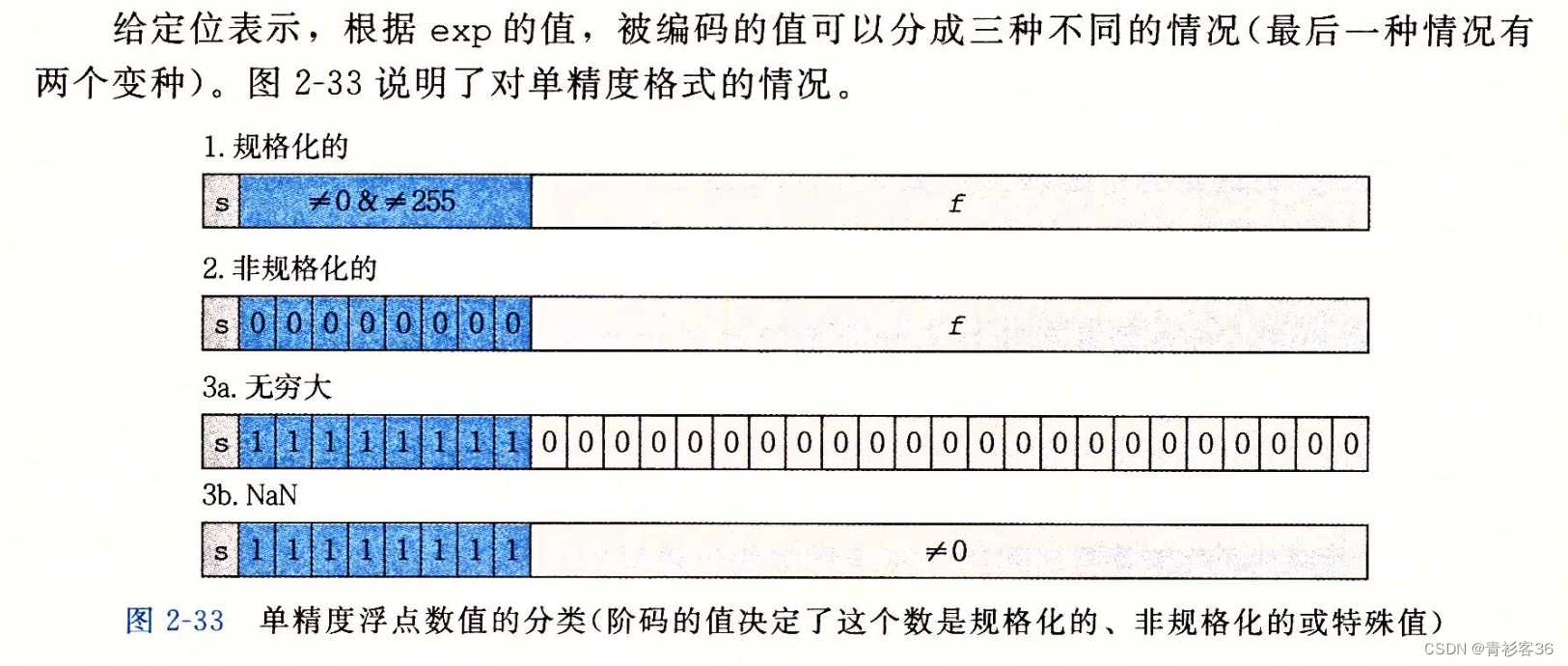
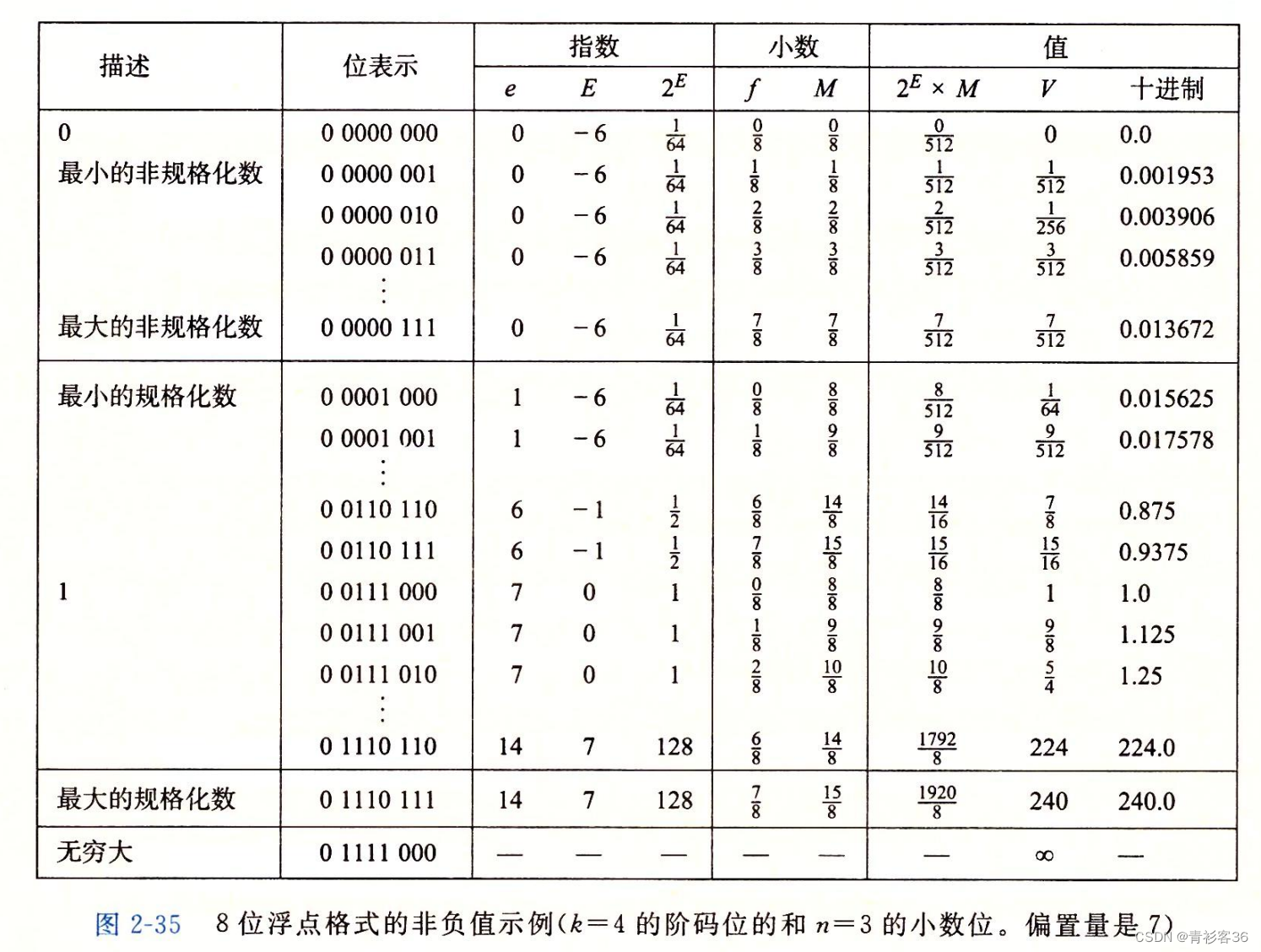
11、floatScale2
// float
/ floatScale2 - Return bit-level equivalent of expression 2*f for* floating point argument f.* Both the argument and result are passed as unsigned int's, but* they are to be interpreted as the bit-level representation of* single-precision floating point values.* When argument is NaN, return argument* Legal ops: Any integer/unsigned operations incl. ||, &&. also if, while* Max ops: 30* Rating: 4*/
unsigned floatScale2(unsigned uf)
{unsigned s = (uf >> 31) & (0x1);unsigned exp = (uf >> 23) & (0xff);unsigned frac = (uf & 0x7fffff);// 0if (exp == 0 && frac == 0)return uf;// 无穷大/NANif (exp == 0xff)return uf;// 非规格化if (exp == 0){// E = exp - 127 = -127// fracfrac <<= 1; // *2return (s << 31) | frac;}// 规格化exp++; // E = exp - 127return (s << 31) | (exp << 23) | (frac);
}12、floatFloat2Int
/ floatFloat2Int - Return bit-level equivalent of expression (int) f* for floating point argument f.* Argument is passed as unsigned int, but* it is to be interpreted as the bit-level representation of a* single-precision floating point value.* Anything out of range (including NaN and infinity) should return* 0x80000000u.* Legal ops: Any integer/unsigned operations incl. ||, &&. also if, while* Max ops: 30* Rating: 4*/
int floatFloat2Int(unsigned uf)
{unsigned s = (uf >> 31) & (0x1);unsigned exp = (uf >> 23) & (0xff);unsigned frac = (uf & 0x7fffff);// 0if (exp == 0 && frac == 0)return 0;// 无限大/NANif (exp == 0xff)return 0x80000000u;// 非规格化if (exp == 0){// M 0.1111... < 1// E = 1 - 127 = -126return 0;}// 规格化// M 1.xXXXXint E = exp - 127;frac = frac | (1 << 23);if (E > 31) // 爆intreturn 0x80000000u;else if (E < 0){return 0;}// M * 2^Eif (E > 23){frac <<= (E - 23);}else{frac >>= (23 - E);}if (s)return ~frac + 1;return frac;
}13、floatPower2
/ floatPower2 - Return bit-level equivalent of the expression 2.0^x* (2.0 raised to the power x) for any 32-bit integer x. The unsigned value that is returned should have the identical bit* representation as the single-precision floating-point number 2.0^x.* If the result is too small to be represented as a denorm, return* 0. If too large, return +INF. Legal ops: Any integer/unsigned operations incl. ||, &&. Also if, while* Max ops: 30* Rating: 4*/
/*非规格化浮点数的范围:2^-149 - 2^-126规格化浮点数的范围: 2^-126 - 2^127
*/
unsigned floatPower2(int x)
{if (x < -149)return 0;else if (x < -126){// E = x// E = 1 - 127 = -126int shift = 23 + (x + 126);return 1 << shift;}else if (x <= 127){// x = exp - biasint exp = x + 127;return exp << 23;}else{return (0xff) << 23;}
}测试结果
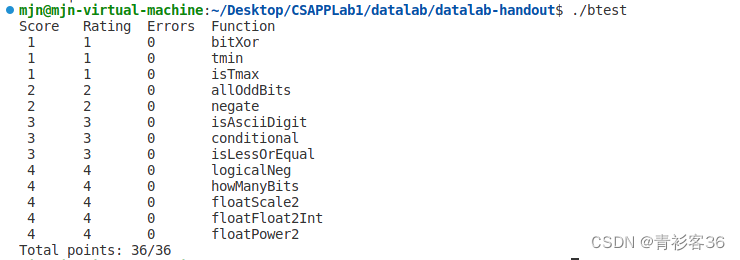
写在最后:笔者仰慕CSAAPLab已久,今日终于可以动手做做了,不得不说,Lab的质量确实高,做完本次实验,感觉自己对计算机中信息位的表示与处理的理解更深了一步,由于写博客的时间比较仓促,博客中出现的问题还请各位大神在评论区批评指正,谢谢大家!


